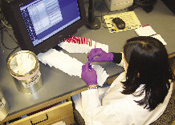Trace Evidence
Trace Evidence
Mission
The Trace Evidence Unit (TEU) identifies and compares specific types of trace materials that could be transferred during the commission of a violent crime. These trace materials include human hair, animal hair, textile fibers and fabric, rope, feathers, soil, glass, and building materials. The physical contact between a suspect and a victim can result in the transfer of trace materials. The identification and comparison of these materials can often associate a suspect to a crime scene or with another individual. Physical anthropology (skeletal remains) examinations are also performed. These examinations are conducted to assist in the identification of human remains.
The Team
Physical scientist, geologist, and forensic examiners
The Work
The unit maintains reference collections of human and animal hair, natural and man-made textile fibers, fabrics, feathers, and wood.
Hair
Hair examinations can determine if a hair is animal or human. If animal, the species and possibly breed of the animal can be determined. If human, the racial characteristics, body area, length, root type (naturally shed/forcibly removed), and any artificial treatment or damage can be determined. Hairs associated by microscopic comparison are also examined by the Mitochondrial DNA Unit.
Fibers
Fiber examinations can determine if a fiber is natural or manmade. Questioned fibers can be compared to fibers from a known source to determine if they are consistent with having originated from that source. Questioned fibers can also be compared to other questioned fibers to determine if they are consistent with originating from the same source, though that source is not known.
Fabric
Fabric examinations can determine if a questioned piece of fabric and a known piece of fabric are consistent in color, construction, and composition. Torn pieces of fabric can be physically matched to a damaged garment.
Feathers
Feather examinations can determine the species of bird that a feather came from, and questioned and known samples of feathers can be compared.
Mineralogy
The FBI Laboratory is one of only a few crime laboratories that provide forensic geologic services. The Mineralogy Group provides both laboratory analysis and field assistance for cases involving geologic evidence. This includes both naturally occurring and man-made geologic materials. Materials examined typically include soil, glass, building materials, and gemstones. Additionally, through an agreement with the U.S. Geological Survey (USGS), the Mineralogy Group can now supplement forensic soil examinations with pollen analysis. Typical examinations include comparison to assess a common origin, identification of an unknown material, and assessment of the geologic origin or geographic attribution of a material (provenance).
Anthropology
Forensic anthropology is the analysis of human skeletal remains in a medico-legal context. The Forensic Anthropology Program (FAP) provides both laboratory analysis and field assistance for cases involving skeletal remains.
08.16.10



